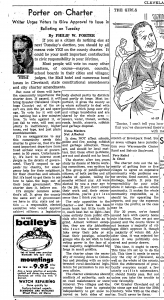WMMS Plain Dealer Sunday Magazine piece by Joe Crea 2/19/1978
http://teachingcleveland.org/wp-content/uploads/2019/02/Joe-Rocks-Out-with-the-Buzzard-Nuclear-Army.pdf
www.teachingcleveland.org
WMMS Plain Dealer Sunday Magazine piece by Joe Crea 2/19/1978
http://teachingcleveland.org/wp-content/uploads/2019/02/Joe-Rocks-Out-with-the-Buzzard-Nuclear-Army.pdf

League of Women Voters Cleveland Hts/Univ Hts Chapter and Heights Public Library Present:
Is Northeast Ohio a Sanctuary Region?
Laws and policies: Where does our region stand on immigration?
The Cleveland.com preview for the forum is here
Video from forum
Wednesday January 17, 2018
From: 7:00-8:30pm
Heights Library Main Branch
2345 Lee Road Cleveland Hts 44118
This panel will take an informed perspective on current Cleveland Hts, Cuyahoga County, Ohio and U.S. immigration policies and laws.
Panelists:
Kahlil Seren, Councilperson, City of Cleveland Heights
Farhad Sethna Esq., Immigration-America
Lynn Tramonte, Deputy Director, America’s Voice
Moderated by Elizabeth Knowles Esq, Immigration & Human Rights Law Clinic, University of Akron
Free and open to the public


October 29, 1950 column by Philip Porter, Plain Dealer endorsing County Charter reform

Plain Dealer columnist Philip W. Porter endorses 1959 Cuyahoga County Charter reform. The creation of an elected official and body of representatives that would assume many of the responsibilities of the local cities and townships.
It lost in November 1959…both Cleveland and many suburbs voted against it.
Great piece by Rich Exner from Cleveland.com comparing Cleveland and Columbus
Columbus is triple the size of Cleveland in area; answers to that and other census questions 5/23/2015 Cleveland.com
CLEVELAND, Ohio – Columbus is nearly triple the size of Cleveland in terms of square miles.
That answers one question that commonly comes up every time the Census Bureau releases new population figures that show Columbus has far more people than Cleveland.
Yes, Columbus is growing. Yes, Columbus is the 15th largest city in the country. Yes, now at an estimated, 835,957 people, Ohio’s capital city is approaching 1 million in population.
And yes, to the chagrin of many proud Clevelanders, Columbus now has more than twice as many residents as Cleveland (389,521).
But population estimates are complicated for many reasons.
So, in the wake of the latest population figures released Thursday for every city in the United States, here are answers to some common questions.
Is Cleveland smaller in square miles than a lot of other major cities?
Yes. The only cities larger in population than Cleveland but smaller in square miles are Miami, San Francisco, Boston, Long Beach, California, and Washington, D.C..
Cleveland measures 77.7 square miles. Columbus is nearly triple the size at 217.2 square miles.
Put another way, Columbus is closer to the combined size of Cleveland, Cincinnati and Toledo (236.3 square miles). Cincinnati is 77.9 square miles and Toledo 80.7, according to the Census Bureau.
Columbus is by far the most populated city in Ohio at 835,957, but it’s not as densely populated as Cleveland.
The latest estimates place Cleveland at 5,013 people per square mile versus 3,849 for Columbus.
As for population, Cleveland (389,521), Cincinnati (298,165) and Toledo (281,031) total almost 1 million people (968,717).
How big are some of the growing cities elsewhere?
Columbus is not alone in topping 200 square miles.
Among the big cities that cover more ground are several from Texas. Austin is 305 square miles, Forth Worth and Dallas are 340 square miles each, San Antonio is 461 square miles and Houston is 600 square miles.
For a comparison, all of Cuyahoga County is 457 square miles.
The three largest cities in excess of 200,000 people are Anchorage (1,704 square miles), Jacksonville (747), Oklahoma City (606) and Houston (600).
Cleveland has so many suburbs. What about the region’s population?
Cuyahoga County remains the most populated county in Ohio, with 1,259,828, according to the latest estimates.
Franklin County (1,231,393) likely will grab that honor soon.
In terms of the metro area, Cuyahoga and the surrounding six counties have an estimated 2.8 million people, far more than the 1.9 million people in Franklin County and the six counties that surround it.
How are the estimates made?
The Census Bureau tries to account for everyone with its once-every-10-year census. In between, the bureau estimates populations.
At the county and state level, the estimates have proven to be very accurate. This is due, in part, to good tracking of births and deaths at the county level, as well as information about people who move from one county to the next.
The annual estimates for cities sometimes can be off. This is because the bureau uses a mix of new and old data to come up with city estimates, based in part on new estimates for housing units and old estimates for vacancy rates.
The Census Bureau first totals the populations for all cities, villages and townships in a county. The estimated population for each community is then adjusted up or down at the same rate so the total matches the estimate for the county.
What we found after the 2010 census is that the earlier estimates were often far off at the city level. But the estimates do offer the best accounting of people available until the next decennial census collections. The alternative is to rely on the 2010 numbers until 2020.
Rich Exner is data analysis editor for the Northeast Ohio Media Group